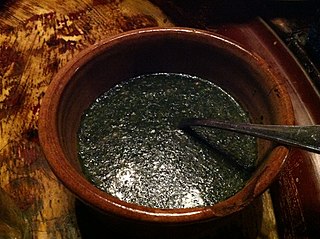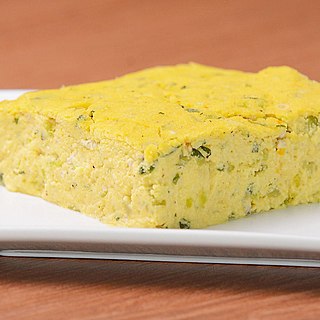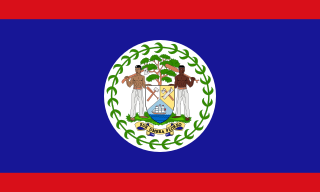
Caribbean cuisine is a fusion of West African, Creole, Amerindian, European, Latin American, Indian/South Asian, Middle Eastern, and Chinese. These traditions were brought from many different countries when they came to the Caribbean. In addition, the population has created styles that are unique to the region.

Gumbo is a hearty stew popular in the U.S. state of Louisiana, and is the official state cuisine. Gumbo consists primarily of a strongly flavored stock, meat or shellfish, a thickener, and the Creole "holy trinity" ― celery, bell peppers, and onions. Gumbo is often categorized by the type of thickener used, whether okra or filé powder.

The zucchini, courgette or baby marrow is a summer squash, a vining herbaceous plant whose fruit are harvested when their immature seeds and epicarp (rind) are still soft and edible. It is closely related, but not identical, to the marrow; its fruit may be called marrow when mature.
Jamaican cuisine includes a mixture of cooking techniques, flavours and spices influenced by Amerindian, African, Irish, English, French, Portuguese, Spanish, Indian, Chinese and Middle Eastern people who have inhabited the island. It is also influenced by the crops introduced into the island from tropical Southeast Asia, many of which are now grown locally. A wide variety of seafood, tropical fruits and meats are available.

Trinidad and Tobago has a unique history and its food is influenced by Indian-South Asian, West African, Creole, European, American, Chinese, Amerindian, and Latin American culinary styles. Trinidad and Tobagonian food is dominated by a wide selection of seafood dishes, most notably, curried crab and dumplings. Trinidad and Tobago is also known for its prepared provisions, such as dasheen, sweet potato, eddoe, cassava, yam, soups and stews, also known as blue food across the country. Corresponding to the Blue Food Day event held annually in Trinidad and Tobago.
Dougla people are Caribbean people who are of mixed African and Indian descent. The word Dougla is used throughout the Dutch and English-speaking Caribbean.

A national dish is a culinary dish that is strongly associated with a particular country. A dish can be considered a national dish for a variety of reasons:

Taro is a root vegetable. It is the most widely cultivated species of several plants in the family Araceae that are used as vegetables for their corms, leaves, stems and petioles. Taro corms are a food staple in African, Oceanic, East Asia, Southeast Asian and South Asian cultures. Taro is believed to be one of the earliest cultivated plants.

Callaloo is a popular Caribbean vegetable dish. There are many variants across the Caribbean, depending on the availability of local vegetables. The main ingredient is an indigenous leaf vegetable, traditionally either amaranth, taro leaves or Xanthosoma leaves.

Callaloo, A Journal of African Diaspora Arts and Letters, is a quarterly literary magazine established in 1976 by Charles Rowell, who remains its editor-in-chief. It contains creative writing, visual art, and critical texts about literature and culture of the African diaspora, and is the longest continuously running African-American literary magazine. Notable writers published include Ernest Gaines, Rita Dove, Yusef Komunyakaa, Octavia Butler, Alice Walker, Lucille Clifton, Edwidge Danticat, Thomas Glave, Samuel Delany, and John Edgar Wideman. It is well known for connecting Black artists from different cultures and sponsoring upcoming writers. It has been published by the Johns Hopkins University Press since 1986.

Amaranthus tricolor, known as edible amaranth, is a species of flowering plant in the genus Amaranthus, part of the family Amaranthaceae.

Mulukhiyah, also known as molokhia, molohiya, or ewedu, is a dish made from the leaves of Corchorus olitorius, commonly known in English as denje'c'jute,nalta jute, tossa jute, jute mallow or Jew's Mallow. It is used as a vegetable and is mainly eaten in the Levant, Egypt, Sudan, Cyprus, Libya, Tunisia and Algeria. It is called “Saluyot” in the Philippines. Mulukhiyah is rather bitter, and when boiled, the resulting liquid is a thick, highly mucilaginous broth; it is often described as "slimy", rather like cooked okra. Mulukhiyah is generally eaten cooked, not raw, and it is either eaten chopped and sautéed in oil, garlic and cilantro like in Syria or turned into a kind of soup or stew like in Egypt, typically bearing the same name as the vegetable in the local language. Traditionally mulukhiyah is cooked with chicken or at least chicken stock for flavor and is served with white rice, accompanied with lemon or lime.

Cou-cou, coo-coo, or fungie makes up part of the national dishes of Antigua and Barbuda, Barbados, British Virgin Islands and the U.S. Virgin Islands. It consists mainly of cornmeal and okra (ochroes). Cornmeal, which comes readily packaged and is available at supermarkets islandwide, and okra, which can be found at supermarkets, vegetable markets and home gardens, are very inexpensive ingredients. Because these main components are inexpensive, the dish became common for many residents in Barbados' early colonial history. In Ghana, a similar meal of fermented corn or maize flour eaten with okra stew and fish is known as banku, a favourite dish of the Ga tribe in Accra.

Laing, is a Filipino dish of shredded or whole taro leaves with meat or seafood cooked in thick coconut milk spiced with labuyo chili, lemongrass, garlic, shallots, ginger, and shrimp paste. It originates from the Bicol Region, where it is known simply as pinangat. Laing is also a type of ginataan, and thus may also be referred to as ginataang laing. Laing is commonly eaten as a vegetable side to complement meat or fish side dishes known as ulam in Filipino, which is normally paired with boiled white rice.
Dominica cuisine is the cuisine of the island nation of Dominica. The cuisine is rooted in creole techniques with local produce flavored by spices found on the island.

Belizean cuisine is an amalgamation of all ethnicities in the nation of Belize and their respectively wide variety of foods. Breakfast often consists of sides of bread, flour tortillas, or fry jacks that are often homemade and eaten with various cheeses. All are often accompanied with refried beans, cheeses, and various forms of eggs, etc. Inclusive is also cereal along with milk, coffee, or tea.
Saint Lucian cuisine is a combination of French, East Indian and British dishes. Before colonization, the Caribs and the Arawaks occupied the island, surviving on its various natural fruits and vegetables like mangoes, oranges, tangerines, avocados, and breadfruits.

Bake and shark is a traditional fast food dish of Trinidadian cuisine prepared using fried flatbread, shark meat and additional ingredients. It is a classic street food dish that is sold at a multitude of food stalls and cookshops all over Trinidad and Tobago.

Oil down is a salted meat and vegetable stew that is the national dish of Grenada.














